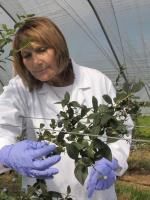
Work Package Crop and grassland production and disease control
Introduction
The overall goal of this RD is to exploit genetic diversity in crop plant germplasm enabling production of plant varieties with improved performance and crop systems which are more resource-use efficient. Diverse germplasm resources harbouring adaptive traits will be key to the successful amelioration of climate change effects on agricultural production. The planned work focuses on traits such as yield stability and responses to changing environmental conditions likely to put our key crops at considerable risk. This RD will be heavily based on the use of well proven genetic approaches to develop crop genetic resources improved for traits that will provide a delivery vehicle for cultivars suitable for future climate change scenarios and for enhanced food security. New methodologies, such as novel phenotyping methods for abiotic stress traits and field assessment of crops, as well as new genotyping platforms for the assessment of diversity, will be developed.
Aim of Research
The major aim is to develop suitably characterised germplasm resources leading to the generation of crops better equipped and adapted to future climatic conditions, taking into account key areas of stakeholder concern that impact on profitability and the sustainability of Scottish crop production. The specific goals are based on identifying relevant genetic diversity in germplasm and developing new phenotyping methods. This is especially important with crop plant research moving towards ‘sustainable intensification’ traits, reduced crop waste and resistance to biotic and abiotic threats to primary production. An ongoing challenge is the threat of future widespread unfavourable stress conditions that will cause annual losses in both yield and crop quality. The work will focus on acquisition and phenotypic and genotypic characterisation of diverse germplasm and the development of genetic tools to facilitate its use. Work will be targeted into key areas of science relevant to UK stakeholders/industry that are also important from a more global perspective (climate change, new pathogen threats, water stress, food security).
Progress
Key aspects of this RD are the generation and genotypic and phenotypic characterisation of various populations for our key Scottish crops, predominantly potato, soft fruit and barley. The research has led to new knowledge of key traits for these crops, as well as the generation of new populations that will facilitate further study into these and other traits. Restricted access to facilities caused by the pandemic did not lead to any significant losses of valuable material, nor to extensive delays in the generation of new populations. Further crosses for our barley, potato and soft fruit population development were carried out and will be taken forward in the new 2022-2027 programme.
Highlights:
For barley a focus of the research continues to be on key barley genes that impact on important yield and resilience traits. Plant surface structures such as waxes and cuticles are important for resilience to environmental stresses and genetic approaches have been used to identify key genes involved in cuticular wax formation. Genes conferring variation in surface wax composition and/or deposition have been identified and functionally characterised and will be reported in the scientific press.
New soft fruit populations for genetic analysis in raspberry and blueberry were developed. For one of these populations (a raspberry association mapping population) genotyping has been performed and in combination with hyperspectral imaging data, genetic regions associated with environmental responses have been identified potentially providing new breeding targets. This population will form part of the new RESAS programme 2022-2027. Additionally, cherry germplasm has been established at an MRP for the first time to support the Scottish and UK industries. A novel automated bee detection methodology has been developed to allow pollinator and flower monitoring. Data on cherry developmental processes and imaging data to help define conditions around June drop. Farmers have been advised on mitigation strategies.
Potato germplasm with diverse salt stress responses has been identified and physiological characterisation of the salt response has been conducted. Unexpectedly, tolerant genotypes that exhibited reduced markers of physiological stress also accumulated higher sodium in leaves suggesting that salt sensitive genotypes prevented salt transport to aerial tissues. On the other hand, transcript analysis suggested that salt tolerant genotypes can modify processes such as photosynthesis and sugar metabolism to maintain energy balance in the presence of salt. These data inform future breeding and genotyping strategies for salt tolerance.
Previously we developed and applied a glasshouse screen for potato tuber yield under heat stress and identified a candidate gene (HSc70) for heat tolerance by genetic analysis of a diploid potato population. Specific allelic variants were expressed at high levels on exposure to moderately elevated temperature due to variations in gene promoter sequence. We confirmed the results from the glasshouse screen in field trials conducted over several seasons and locations including those in Kenya, Malawi and the UK. We extended our understanding of the HSc70 gene and demonstrated that expression level of HSc70 correlates with tolerance to heat stress in a wide range of wild potato relatives. The physiological basis of the protective effect of HSc70 was explored and we showed that genotypes carrying the highly expressed HSc70 A2 allele are protected against photooxidative damage induced by abiotic stresses. Genetic analysis of a panel of 300 potato varieties for yield confirms the importance of the HSc70 locus.
Significant progress was made in adding new features and in incorporating datasets into the Germinate databasing platform. For example, phenotypic data for 220 barley lines for traits associated with performance was collected from plants grown in a polytunnel, and genetic data and gene expression data were incorporated into a GERMINATE database. These datasets will help identify processes associated with yield and have the potential to inform breeding programmes. The Forward Breeding Module and an experimental Indexed Forward Breeding module were added to Flapjack and released as part of the current Flapjack version. New phenotype upload and validation tools have been developed. Links to the JHI National Seedstore have been established and the genotypic data has been distributed using the Germinate platform.
An Illumina next-generation sequencing (NGS) based Single Primer Enrichment Technology (SPET) genotyping platform has been designed based on 90,000 potato genetic markers. Due to the delay in the delivery of SPET reagents, SPET genotyping could not be performed. However, two large and diverse potato panels (European and Peruvian potato panels) were genotyped using high-density genotyping-by-sequencing. Using data from these new panels and a previously characterized potato association panel, GWAS and genomic prediction modelling were performed for strategically important traits including tuber yield and dry matter. Bioinformatic analysis and genetic characterization of a diverse potato germplasm collection using genic-region genetic markers (SNPs) is complete. The collection comprised samples from Brevicaule, Andigena, Phureja, Phureja Core and tuberosum including very old (pre 1900s), relatively old (post 1950) and new (post 2000) potato.
Key aspects of this RD are the generation and characterisation, both genotypic and phenotypic, of various types of populations for our key Scottish crops predominantly potato, soft fruit and barley. The research has led to new knowledge of key traits for these crops, as well as the generation of new populations that will facilitate further study into these and other traits. Restricted access to facilities caused by the pandemic did not lead to any losses of valuable material, nor to extensive delays in the generation of new populations. Further crosses for our barley, potato and soft fruit population development were carried out and will be taken forward in year 6.
For barley a focus of the research is on key barley genes that impact on important yield and resilience traits. Inflorescence structure in barley is important for yield and progress continues in identifying and characterising key changes that impact in this area. Plant surface structures such as waxes and cuticles are important for resilience to environmental stresses and genetic approaches have been used to identify key genes involved in cuticular wax formation.
Significant progress was made in adding new features and in incorporating datasets into the Germinate databasing platform. For example, phenotypic data for 220 barley lines for traits associated with performance was collected from plants grown in a polytunnel, and genetic data and gene expression data were incorporated into a GERMINATE database. These datasets will help identify processes associated with yield and have the potential to inform breeding programmes.
New soft fruit populations for genetic analysis in raspberry and blueberry were developed. For one of these populations (a raspberry association mapping population) genotyping has been performed and in combination with hyperspectral imaging data, genetic regions associated with environmental responses have been identified potentially providing new breeding targets. Additionally, cherry germplasm has been established at an MRP for the first time to support the Scottish and UK industries. A novel automated bee detection methodology has been developed to allow pollinator and flower monitoring.
Pest and disease phenotyping for potato populations for late blight and PCN was continued, as well as heat and drought phenotyping of CPC and other material. Outputs of combined heat and drought stress experiments in potato suggest mechanisms of how the potato plant protects itself from abiotic stresses. Detailed characterisation of variation in a newly discovered heat tolerance gene, associated with stress resilience is complete. Next-generation sequencing data has been acquired from 96 diverse potato genotypes using a novel ‘whole exome capture’ (WEC) platform and first stage bioinformatic analysis for potato genic variants is complete. These data will inform the development of a completely novel potato genotyping platform in year 6 that will be used for potato genotyping at JHI going forward. Additionally, a Genomic Selection strategy for potato, targeting tuber yield, dry matter and other key potato traits has been developed. The work involved assessment of genomic data from 300 diverse potato varieties using a set of 45,000 genetic markers. The strategy is available for exploitation in practical potato breeding by commercial companies.
Highlights:
The Germinate platform is an invaluable resource for assessing and managing diversity. This year further features have been added to the platform. GridScore allows collection of data from field trial plots and a feature to allow tagging of images is in preparation. New web and social media presence is being developed to promote Germinate tools and the work has been presented to fruit breeding companies as well as disseminated via scientific publications.
Progress in the last year has included the assembly of geo-referenced barley genotypes, extensive genotyping of potato genetic resources and development of new databases that makes information about barley, potato and soft fruit varieties more accessible to the end-user community. Extensive genotyping of the potato germplasm collection (CPC), was carried out with leveraged funding and this data will be incorporated into the Germinate platform via a project with the Global Crop Trust. Further new populations of barley, potato and raspberry have been developed and characterised by phenotyping and molecular markers. In potato the shift towards developing novel diploid material for research and breeding continues, with stakeholder engagement.
Highlights:
Phenotyping of wheat, barley and potato populations has led to the development of tools for crop breeding. Examples include markers for dormancy, tuber initiation, greening and late blight resistance in potato, the latter of which are being actively deployed in breeding.
The development of a unique new diploid potato population has been progressed significantly as a further step in developing the necessary potato lines for genetic improvement. Once complete, this research will enable us to incorporate useful traits from our potato germplasm collections into potato breeding lines.
Work on raspberry populations has allowed us to understand the genetic factors underlying ‘day neutral’ ripening. A range of quality and resistance traits have been assessed using genomic and genetic resources and imaging technologies. Novel association mapping populations have been developed in raspberry and blueberry and will be used for genetic studies. Genomics resources have been deployed to understand important traits in the soft fruit crops.
Genotypes from a diploid potato population carrying different forms of genes for heat tolerance, maturity and virus resistance were identified and analysed in controlled environment experiments. The same genotypes were field trialled with partners in Kenya and Malawi. Controlled environment experiments identified differences in photosynthetic performance associated with tolerance or susceptibility to heat and drought combinations. A paper describing the physiological biochemical and transcriptional responses of potato genotypes to combinations of abiotic stresses has been published.
Mobile based applications for in-field data scoring have been much improved and these are now being used by barley, potato and soft fruit researchers to reduce errors and increase the speed of experimental data collection. Improved germplasm tracking and seed-store ordering systems, and visualization tools for diversity data are being developed. Results were presented at KE events including Cereals in Practice (Old Meldrum) and The Royal Highland Show 2019.
New populations of barley, potato and raspberry have been developed and further characterised. In potato a shift towards using diploid inbred parents for crossing will provide better trait resolution and allow MRP participation in global diploid breeding efforts. Two diverse collections of geo-referenced barley landraces and wild species have been obtained and multiplied and deposited in the seed store at JHI for ongoing and future studies. A third collection of Ethiopian barley landraces has been obtained and is growing in 2019. These are being used for a variety of studies.
Phenotyping of wheat, barley and potato populations is leading to further development of tools for crop breeding. Examples include markers for dormancy, tuber initiation and late blight resistance in potato, the latter of which are being actively deployed in breeding.
We have developed mobile based applications for the scoring of data in the field and worked towards developing systems to reduce the errors associated with collection of data. We continue to improve these tools and they are now being used by barley, potato and soft fruit groups to reduce errors and increase the speed at which experimental data can be collected. We are also developing improved germplasm tracking and seed store ordering systems.
Highlights:
- We have improved our ability to store and handle large genotypic datasets in barley including the recent barley 50K array and have developed tools to allow the efficient storage and retrieval of data based on defined germplasm lists. We have loaded this genotypic data into our database and included interfaces to allow searching.
- We have developed additional functionality into our Flapjack, Helium and CurlyWurly analysis tools to aid geneticists and plant breeders. The development and improvement of our software has led to successful SEFARI Responsive Mode funding as well as approaches from a number of groups to collaborate on H2020 funding applications in 2019.
- Work on fruit ripening in raspberry has provided new insights into gene regulation.
New populations of barley, potato and raspberry have been developed and further characterised. These include landrace populations and wild relatives of barley, the development of a "taxonomic core" population from the Commonwealth Potato Collection and the use of a raspberry population for genetic analysis.
Phenotyping of barley, wheat and potato populations are leading to the identification of novel markers, genes and breeding strategies. Examples include genes that impact on nutrient use efficiency in cereals and markers that can be used to reduce waste through tuber greening in potato.
The focus was on transcriptomics in barley and raspberry and new resources in potato genomics. In these areas new tools have been developed that will underpin new breeding strategies in the future. For example, progress has been made in understanding resilience of crops to abiotic stresses from analysis of transcriptomic datasets.
Highlights:
- A new version of Flapjack, a powerful breeding application developed in collaboration with the Genomic and Open-source Breeding Informatics Initiative: Flapjack provides visualization and analysis of high-throughput genotype data to enable breeders to select the best possible parental lines and perform marker-assisted backcrossing.
- Sustainable Agriculture Research & Innovation Club (SARIC) funding success to develop tools to predict and diagnose crop response to water and nutrient related limits, for more sustainable and efficient production using precision agriculture.
- Raspberry reference populations have been planted under 8 different biotic and abiotic stress conditions to allow mapping of resilience traits and for gaining a better understanding of seasonality which is changing due to climatic variability. A paper on fruit softening has been published.
- A new barley SNP marker chip was developed.
- Developing new crop types Potato tuber yield is highly susceptible to elevated temperature and heat tolerant varieties are important for Scottish seed exports (ca. 90K tonnes per annum) to growing markets in warm countries. This work has identified heat tolerant varieties and gene markers for this trait. The work is being extended via co-funding from Global Challenge Research Fund (UKRI GCRF). In collaboration with partners in Kenya and Malawi, potato types carrying alleles for heat tolerance, rapid maturity and virus resistance are being trialled in warm and dry environments, underpinning efforts to expand potato production in hot environments. The research will assist breeders in developing heat tolerant varieties, particularly important for seed exports to warmer countries. (Trapero-Mozos et al., 2017).
Improved germplasm collections and genetic populations have been developed for barley, potato and soft fruit species. The research in the first year of the programme focussed mainly on the assembly and characterisation of germplasm resources for the purposes of assessing and analysing traits key adaptation and amelioration of climate change impacts.
Phenotyping efforts are in progress in cereals, potatoes and soft fruit - characterising traits of key importance to maintain or improve productivity in crops of major importance to Scotland.
Bioinformatic and genomic tools are being developed and are finding application in crop improvement strategies detailed in the sub-objective outputs below.
Bioinformatic and genomic tools are being developed and are finding application in crop improvement strategies. The Germinate bioinformatics tool has been developed for dissemination of experimental data for various species including the Commonwealth Potato Collection and wild barley accessions. Several publications and KE activities including the development of a website have further publicised the Germinate tool to scientists and industry.
Detailed transcriptome sequencing of raspberry and blackcurrant varieties has been completed and is assisting in efforts to develop the entire gene sequence for these species. The approach has revealed new gene markers that will find application in breeding improved varieties. This work has leveraged significant industrial co-funding. Available germplasm and expertise has also allowed us to be involved in community projects aimed at reducing food poverty and low educational skills. This has also allowed us to gain some funding to support community development further through the innovate funded Tayberry project
Highlights:
- Data has been collected from 300 landraces and 116 wild geo-referenced barley accessions, with over one million SNPs (genetic differences) identified, enabling variation associated with adaptation to different environments to be analysed. The data has formed the basis of a high impact publication in Nature Genetics.
- A new version of Flapjack, a powerful breeding application developed in collaboration with the Genomic and Open-source Breeding Informatics Initiative: Flapjack provides visualization and analysis of high-throughput genotype data to enable breeders to select the best possible parental lines and perform marker-assisted backcrossing (RD2.1.1).
- Work on variation in grain skinning among spring barley varieties induced by a controlled environment misting screen has been published.
- For potato and barley ‘genome complexity reduction’ platforms have been developed, allowing targeted resequencing of genomic regions harbouring trait genes.
- For barley genome wide association mapping of important micro-nutrients (sodium, cadmium, phosphate, manganese, calcium, lead, iron, zinc, copper, iron, selenium and molybdenum) has identified several candidate genes involved in their accumulation. This work will underpin efforts to develop nutritionally improved barley varieties. This work has formed the basis of a KE demonstration at Cereals in Practice, July 2016 where work on managing grain N concentration in barley was presented to the cereal industries.
Future Activities
The continued development of plant material and tools to study genomes will allow us to gain a better understanding of important crop characteristics and how they can be used in Scottish plant breeding. Novel approaches will be further employed to characterise our crop resources revealing novel versions of genes to be used for crop improvement. The development of new potato populations will make the complex analysis of characteristics easier and will make it more straightforward to incorporate beneficial characteristics into plants. New methods for looking at genetic and physical characteristics will be further developed for soft fruit species and will allow the development of robust varieties
Selected Outputs
Giolai, M., Paajanen, P., Verweij, W., Percival-Alwyn, L., Baker, D., Witek, K., Jupe, F., Bryan, G., Hein, I., Jones, J.D. and Clark, M.D., 2016. Targeted capture and sequencing of gene-sized DNA molecules. Biotechniques, 61(6), pp.315-322.
Russell, J., Mascher, M., Dawson, I.K., Kyriakidis, S., Calixto, C., Freund, F., Bayer, M., Milne, I., Marshall-Griffiths, T., Heinen, S. and Hofstad, A., 2016. Exome sequencing of geographically diverse barley landraces and wild relatives gives insights into environmental adaptation. Nature Genetics, 48(9), p.1024.
Van Weymers, P.S., Baker, K., Chen, X., Harrower, B., Cooke, D.E., Gilroy, E.M., Birch, P.R., Thilliez, G.J., Lees, A.K., Lynott, J.S. and Armstrong, M.R., 2016. Utilizing “Omic” technologies to identify and prioritize novel sources of resistance to the oomycete pathogen Phytophthora infestans in potato germplasm collections. Frontiers in plant science, 7, p.672.
Bayer, M.M., Rapazote-Flores, P., Ganal, M., Hedley, P.E., Macaulay, M., Plieske, J., Ramsay, L., Russell, J., Shaw, P.D., Thomas, W., Waugh R. (2017) Development and Evaluation of a Barley 50k iSelect SNP Array. Front. Plant Sci., 17. https://doi.org/10.3389/fpls.2017.01792
Craig G. Simpson, Danny W. Cullen, Christine A. Hackett, Kay Smith, Paul D. Hallett, Jim McNicol, Mary Woodhead, Julie Graham (2017) Mapping and expression of genes associated with raspberry fruit ripening and softening. Theoretical and Applied Genetics 130 (3) 557–572.
Mascher, M., Gundlach, H., Himmelbach, A., Beier, S., Twardziok, S.O., Wicker, T., Radchuk, V., Dockter, C., Hedley, P.E., Russell, J. and Bayer, M., 2017. A chromosome conformation capture ordered sequence of the barley genome. Nature, 544(7651), p.427.
Trapero‐Mozos, A., Morris, W.L., Ducreux, L.J., McLean, K., Stephens, J., Torrance, L., Bryan, G.J., Hancock, R.D. and Taylor, M.A., 2018. Engineering heat tolerance in potato by temperature‐dependent expression of a specific allele of HEAT‐SHOCK COGNATE 70. Plant biotechnology journal, 16(1), pp.197-20
Armstrong, M.R., Vossen, J., Lim, T.Y., Hutten, R.C., Xu, J., Strachan, S.M., Harrower, B., Champouret, N., Gilroy, E.M. and Hein, I., 2019. Tracking disease resistance deployment in potato breeding by enrichment sequencing. Plant biotechnology journal, 17(2), pp.540-549.
Chen, X., Lewandowska, D., Armstrong, M.R., Baker, K., Lim, T.Y., Bayer, M., Harrower, B., McLean, K., Jupe, F., Witek, K. and Lees, A.K., 2018. Identification and rapid mapping of a gene conferring broad-spectrum late blight resistance in the diploid potato species Solanum verrucosum through DNA capture technologies. Theoretical and applied genetics, 131(6), pp.1287-1297.
Hackett, C.A.Milne, L., Smith, K., Hedley, P., Morris, J., Simpson, C.G., Preedy, K., and Graham, J. (2018) Enhancement of Glen Moy x Latham raspberry linkage map using GbS to further understand control of developmental processes leading to fruit ripening. BMC Genetics 19:59 https://doi.org/10.1186/s12863-018-0666-z
Bustos‐Korts, D., Dawson, I.K., Russell, J., Tondelli, A., Guerra, D., Ferrandi, C., Strozzi, F., Nicolazzi, E.L., Molnar‐Lang, M., Ozkan, H. and Megyeri, M., 2019. Exome sequences and multi‐environment field trials elucidate the genetic basis of adaptation in barley. The Plant Journal, 99(6), pp.1172-1191.
Darrier, B., Russell, J., Milner, S.G., Hedley, P.E., Shaw, P.D., Macaulay, M., Ramsay, L.D., Halpin, C., Mascher, M., Fleury, D.L. and Langridge, P., 2019. A comparison of mainstream genotyping platforms for the evaluation and use of barley genetic resources. Frontiers in plant science, 10, p.544
Demirel, U., Morris, W.L., Ducreux, L.J., Yavuz, C., Asim, A., Tindas, I., Campbell, R., Morris, J.A., Verrall, S.R., Hedley, P.E. and Gokce, Z.N., Caliskan, S., Aksoy E., Mehmet, E., Caliskan, M.E., Taylor M.A. and Hancock, R.D. 2020. Physiological, Biochemical, and Transcriptional Responses to Single and Combined Abiotic Stress in Stress-Tolerant and Stress-Sensitive Potato Genotypes. Frontiers in Plant Science, 11, p.169.
Foster, T.M., Bassil, N.V., Dossett, M., Worthington, M.L. and Graham, J., 2019. Genetic and genomic resources for Rubus breeding: A roadmap for the future. Horticulture Research, 6(1), pp.1-9.
Okamoto, H., Ducreux, L.J., Allwood, J.W., Hedley, P., Gururajan, V., Wright, A., Terry, M.J. and Taylor, M.A., 2020. Light regulation of chlorophyll and glycoalkaloid biosynthesis during tuber greening of potato S. tuberosum. Frontiers in Plant Science, 11, p.753. 3
Owen, H., Pearson, K., Roberts, A.M., Reid, A. and Russell, J., 2019. Single nucleotide polymorphism assay to distinguish barley (Hordeum vulgare L.) varieties in support of seed certification. Genetic Resources and Crop Evolution, 66(6), pp.1243-1256.
Schreiber, M., Mascher, M., Wright, J., Padmarasu, S., Himmelbach, A., Heavens, D., Milne, L., Clavijo, B.J., Stein, N. and Waugh, R., 2020. A genome assembly of the barley ‘transformation reference’cultivar Golden Promise. G3: Genes, Genomes, Genetics, 10(6), pp.1823-1827
Torrance, L., Cowan, G.H., McLean, K., MacFarlane, S., Al-Abedy, A.N., Armstrong, M., Lim, T.Y., Hein, I. and Bryan, G.J., 2020. Natural resistance to Potato virus Y in Solanum tuberosum Group Phureja. Theoretical and Applied Genetics, 133(3), pp.967-980.
Bretani, G., Rossini, L., Ferrandi, C., Russell, J., Waugh, R., Kilian, B., Bagnaresi, P., Cattivelli, L. and Fricano, A., 2020. Segmental duplications are hot spots of copy number variants affecting barley gene content. The Plant Journal, 103(3), pp.1073-1088.
Raubach, S., Kilian, B., Dreher, K., Amri, A., Bassi, F.M., Boukar, O., Cook, D., Cruickshank, A., Fatokun, C., El Haddad, N. and Humphries, A., 2021. From bits to bites: Advancement of the Germinate platform to support prebreeding informatics for crop wild relatives. Crop Science, 61(3), pp.1538-1566.
Williams, D., Hackett, C.A., Karley, A., McCallum, S., Smith, K., Britten, A., Graham, J 2021. Seeing the wood for the trees: hyperspectral imaging for high throughput QTL detection in raspberry, a perennial crop species. Fruit Research, 2021, 1:7.









